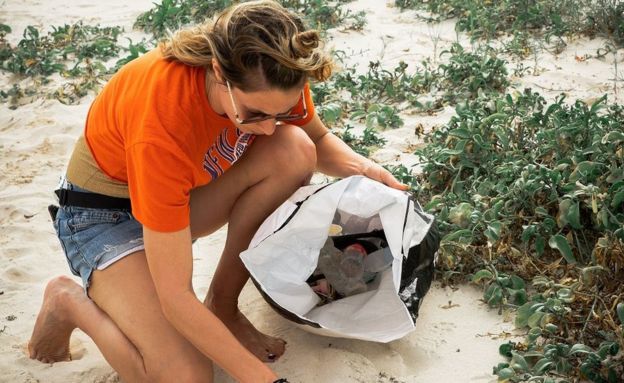
Last week, a report from the World Meteorological Organisation found that the world is warming faster than previously believed, and could warm by between three to five degrees Celsius by the end of the century—that’s almost three times the goal set by the Paris climate agreement.
But amid the doom and gloom, there are reasons for us to be optimistic. Even Assaad Razzouk, the outspoken chief executive of Singapore-based renewables firm Sindicatum, has started to believe there is hope for the planet. On his podcast Angry Clean Energy Guy, recorded on Thursday, Razzouk highlighted 10 reasons for climate optimism. Those reasons are as follows:
Climate action is intensifying
The corporate response to climate change is growing ever stronger, and governments are finally responding too, prompted by a global upswell in climate activism.
“Do you think the point of the Extinction Rebellion protests is to close roads? Or that Greta Thunberg travels by boat because she wants to save fuel? Of course not. The point is to increase awareness about the climate emergency. And, boy, have they been successful,” said Razzouk on his podcast.
Cost reductions [of renewables] have basically taken fossil fuel power out of the game. It’s just that some countries don’t know that yet.
Assaad Razzouk, chief executive, Sindicatum Sustainable Resources
Among the big corporates to think harder about reducing their impact are Kellogg’s, the cereal company, which aims to train 500,000 American farmers in techniques that lower greenhouse gas emissions, and the big tech giants Facebook, Google and Apple, which want to only use renewables to power their energy-guzzling data centres.
In Southeast Asia, the only region in the world where coal is growing in the energy mix, the regional bloc’s three biggest banks, UOB, DBS and OCBC, all declared in an unprecedented 11 days for corporate climate action in May that they would all stop funding new coal-fired power plants.
As for consumers, the demand for green products is another reason for the eco anxious to quit the Xanax. According to study by market research group Nielsen, a quarter of all store sales in the United States will be from sustainable products by 2021.
Meanwhile, governments including Ireland, the United Kingdom, California and the European Union, which recently declared a state of climate emergency, have taken bold leaps to curb emissions. In Asia Pacific, the leader is New Zealand. The government has passed a law to cut carbon emissions to almost zero by 2050, go 100 per cent renewables by 2035, plant one billion trees and invest $15 billion in transit, biking and walking infrastructure.
Oil and gas cost of capital is rising
The cost of capital for oil and gas is growing, which has meant that the market value of America’s energy sector not only fell this year, but the whole sector is now worth less than Apple’s stock, Razzouk said.
He pointed to the downgrading of the credit rating of Exxon Mobil, one of the world’s biggest (mostly oil) energy companies, as a result of the rising cost of gas extraction, and the nose-dive in market value of fracking giant Chesapeake over the last decade (down 98 per cent), as signs that the era of fossil fuels dominance is coming to an end.
“Over the next few years, Big Oil will find it increasingly hard and increasingly expensive to finance new projects,” said Razzouk.
Renewables costs are still falling
The costs for renewable energy tech fell to a record low last year, according to the International Renewable Energy Agency, with the biggest fall in solar, down by 26 per cent.
Razzouk pointed to bids to build solar parks in Dubai, which have seen costs plummet by 71 per cent in five years, and a 31 per cent fall in the cost of offshore wind—now the cleanest and cheapest baseload power in the world—in the UK in two years, as evidence that costs are continuing to fall for clean energy.
“These cost reductions have basically taken fossil fuel power out of the game. It’s just that some countries don’t know that yet,” said Razzouk.
Transport is going electric—fast
The number of public charging points for electric vehicles has increased five-fold in four years, from less than 200,000 in 2015 to 1m in 2019, the price of lithium-ion batteries has fallen by 87 per cent in a decade, and cities are being redesigned away for electric vehicles, Razzouk noted.
And automative manufacturers have finally caught on. According to Razzouk’s calculations, 84 models are being rolled out over the next two years from the likes of Volkswagen (VW), Audi, Porsche, Mercedes, Ford, Toyota, Honda, Nissan, Range Rover and Jaguar, and automakers such as BMW, VW, General Motors and Peugeot are now offering electric scooters and electric bicycles, not just cars.
We are winning [the climate fight]. For now, slowly, slowly, but soon we’re going to be winning all of a sudden.
“The transition to electric cars would have been a lot less painful for the car industry if it had spent the last decade preparing for it instead of fighting it. So today they’re laying off people when they shouldn’t have, had they been thinking.”
But the electric mobility revolution is not just about cars. Taiwanese electric bicycle firm Giant is selling 600,000 units a year, while there are 100 different electric planes in development.
Perhaps most promising of all is that new technology enables electric vehicles to supply energy back to the grid, rather than suck from it.
“There’s an emerging technology called vehicle-to-grid (V2G), and that allows a plug-in vehicle to act as a form of energy storage. So the batteries in your car can be used to let electricity flow from the car to the distribution network and back,” Razzouk said.
Climate litigation
According to Columbia Law School, there are 1,640 lawsuits fighting fossil fuel companies and governments over climate change right now.
“Even though we are in a planetary emergency, we are fighting back,” said Razzouk, who noted that climate lawsuits are exposing the “misinformation and obfuscation” of Big Oil, which has long known of the impact of their operations on the climate.
“The wheels of justice are slow and sadly, justice maybe cannot be guaranteed to prevail in some countries, but the sheer number of lawsuits and the dedication, commitment, and passion I’ve seen from those launching them is a big cause for optimism,” Razzouk said.
Banks are waking up to the climate reality
Beyond credit ratings agency Moody’s considering stripping Exxon Mobil of its triple-A rating, the European Central Bank is considering including climate considerations in how it conducts its monetary policy. “Now that would be a huge move because central banks are by far the biggest influence on financial markets,” said Razzouk.
Monetary policies, Razzouk explained, have an implicit “carbon bias” because carbon exposure is almost irrelevent for normal credit ratings. If that changed, financial markets would stop mispricing climate risks—which would be a huge lever for change, he said.
The war on plastic
A report from the International Energy Agency, released in October 2018, found that plastic and other petrochemicals are becoming the biggest driver of global oil demand—ahead of cars, planes and trucks—and will make up nearly half of oil demand by 2050.
But the global fight against plastic pollution could put a big dent in oil demand, Razzouk said.
This drop in demand will have consequences for the cost of capital of oil and gas companies. This means that they will be able to do no more new oil and gas exploration and close down, gradually, Razzouk suggested.
Reforestation
Though forest fires have raged in Indonesia, the Amazon, California and Australia this year, many countries around the world are building forest fortresses to lock in carbon and safeguard water resources, and there are now more protected nature and marine areas than at any time in history.
China, India and Pakistan are rolling out massive tree-planting schemes, Ethiopia recently planted 350 million trees in a single day as part of an initiative to plant four billion trees, and in Western Europe, forests have grown by an area larger than Switzerland in a decade.
Peak emissions
After increasing at the fastest rate for seven years in 2018, global carbon emissions are set to rise much more slowly this year, according to data from the Global Carbon Project.
The global economy grew by 3.5 percent per year, but emissions grew by only 0.8 per cent per year, Razzouk pointed out. “Now that’s still a disaster because they [emissions] are growing. But the growth phase is slower. We’ve seen a 1.5 per cent increase in 2017, 2.1 per cent in 2018 and now it’s dropped to 0.8 per cent.”
“One more push by all of us, and we will set off on a downward slope for emissions,” he said.
Citizen activism
Even just a year ago, it couldn’t reasonably be believed that much of the world really cared about the climate crisis, Razzouk said.
Now though, he said, he sees much more commitment to tackle the climate emergency.
“We have activist lawyers, activist teachers, activist unionists, activist engineers, activist consultants, and activist politicians. We even have some activist bankers. We even have some activist oil and gas professionals working at changing the oil and gas fat cats from the inside. And most important of all, we have activist citizens everywhere I look.”
Clilmate solutions are available, and slowly but surely, they are being implemented, and soon they will be as ubiquitous as our mobile phones, he said.
“We are winning [the climate fight]. For now, slowly, slowly, but soon we’re going to be winning all of a sudden,” said Razzouk, who started his podcast by declaring that a friend recently unfollowed him on Twitter, because he found his tweets to be “too depressing.”
Singapore-based renewables executive Assaad Razzouk is the creator of the Angry Clean Energy Guy podcast series, and has 137,000 followers of his environment-themed Twitter account.
By Robin Hicks
www.eco-business.com























